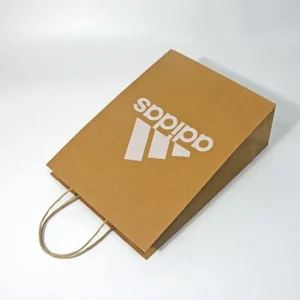Paper bags have become the preferred choice for eco-conscious consumers and businesses worldwide. But what exactly are paper bags made of? Understanding the materials and processes behind paper shopping bags—especially brown paper bags—helps us make informed choices about sustainability, strength, and design.
Ⅰ. Materials for making paper bags

1. Material core: Kraft Paper
Paper bags usually use kraft paper, the raw material of which is mainly wood pulp treated by chemical pulping. It can use virgin fiber or recycled fiber to meet the bag-making requirements for strength and environmental protection.
Kraft paper is wood pulp obtained through the Kraft pulping process, which has the characteristics of tough structure and strong tear resistance.
During production, alkaline liquid (sodium hydroxide and sodium sulfide) is used to decompose lignin, thereby retaining more fiber structure and improving the strength of paper.
2. Color classification: white and brown kraft paper
- Brown kraft paper: unbleached, natural color, strong because it contains lignin; most kraft paper bags use this type.
- White kraft paper: bleached to remove lignin, whiter in appearance and suitable for printing, but bleaching may weaken some fiber strength.
Ⅱ. Introduction to the production process
The process of making kraft paper bags includes the following key steps:
- 1. Raw material preparation: Softwood species such as pine and spruce are usually selected because they have long fibers and are suitable for enhancing the strength of the finished product.
- 2. Chemical pulping (Kraft process): Mix wood chips with sodium hydroxide and sodium sulfide, and separate fibers and lignin through high temperature and high pressure treatment to produce high-strength pulp.
- 3. Washing, screening, and pulping process: Remove impurities and improve the fiber bonding effect through pulping. If necessary, add starch, resin, wax, and other reinforcing agents to improve moisture resistance or printing properties.
- 4. Paper forming, pressing, and drying: Form a paper curtain on the paper machine, press and heat dry, and finally obtain kraft paper.
- 5. Post-processing: Cutting, printing, assembling handles (such as flat handles, twisted ropes, punched handles, etc.), and adding degradable coatings or linings as needed.
Ⅲ. Other types of paper bag materials are available
In addition to the common Kraft paper, there are also the following types of materials that can be used for different design needs:
- Coated paper: such as C1S, C2S coated paper, with a smooth surface, suitable for printing high-end gift bags.
- Corrugated paper or multi-layer cardboard: used for paper bags with stronger structures or bag bottom enhanced packaging.
- Recycled paper: recycled from old paper to make kraft paper, environmentally friendly, but slightly lower in strength.
- Special lining paper: containing a foil layer, antistatic or oil-proof and waterproof materials. It is used for food packaging or gift packaging to improve barrier properties.
Ⅳ. Performance and environmental advantages
- Tear resistance and strong load-bearing capacity: Kraft paper uses the long fiber chemical pulping process, with significant strength advantages. It is suitable for daily applications such as shopping bags, food bags, book bags, etc.
- Degradable and recyclable: Kraft paper is a biodegradable and recyclable material. European research shows that the average number of fiber recycling times is 2.4-3.6 times, which can effectively reduce resource waste.
- Low carbon footprint: The average carbon emission of some European paper bags during their life cycle is 85g CO₂e, which can be negative (–35g CO₂e) if biomass carbon absorption is taken into account. It has positive environmental benefits.
V. Information summary
| Item | Content |
| Raw materials | Wood pulp (pine, spruce and other softwoods) |
| Pulping method | Kraft chemical pulping (alkali + sodium sulfide treated lignin) |
| Paper type | Unbleached brown Kraft paper/bleached white Kraft paper |
| Enhancing additives | Starch, resin, wax, etc. (to improve wet strength, moisture resistance, printing quality) |
| Bag making method | Cutting, printing, handle assembly (such as flat handle, twist rope, etc.) |
| Performance | High strength, tear resistance, stackable, load-bearing (depending on gram weight) |
| Environmental performance | Degradable, recyclable, low carbon footprint, in line with the concept of sustainable packaging |
VI. Conclusion
Paper bags are mainly made of Kraft paper, which is derived from wood pulp raw materials from chemical pulping. It has high strength and good load-bearing capacity, and can be selected in brown or bleached white types. If necessary, adding reinforcing agents can further improve functionality. In addition to Kraft paper, there are also different materials such as coated paper, multi-layer cardboard, recycled paper, and special lining paper to meet different packaging needs.
As a leader in paper bag suppliers, Nanwang offers a full range of paper bags. Welcome to contact us!





